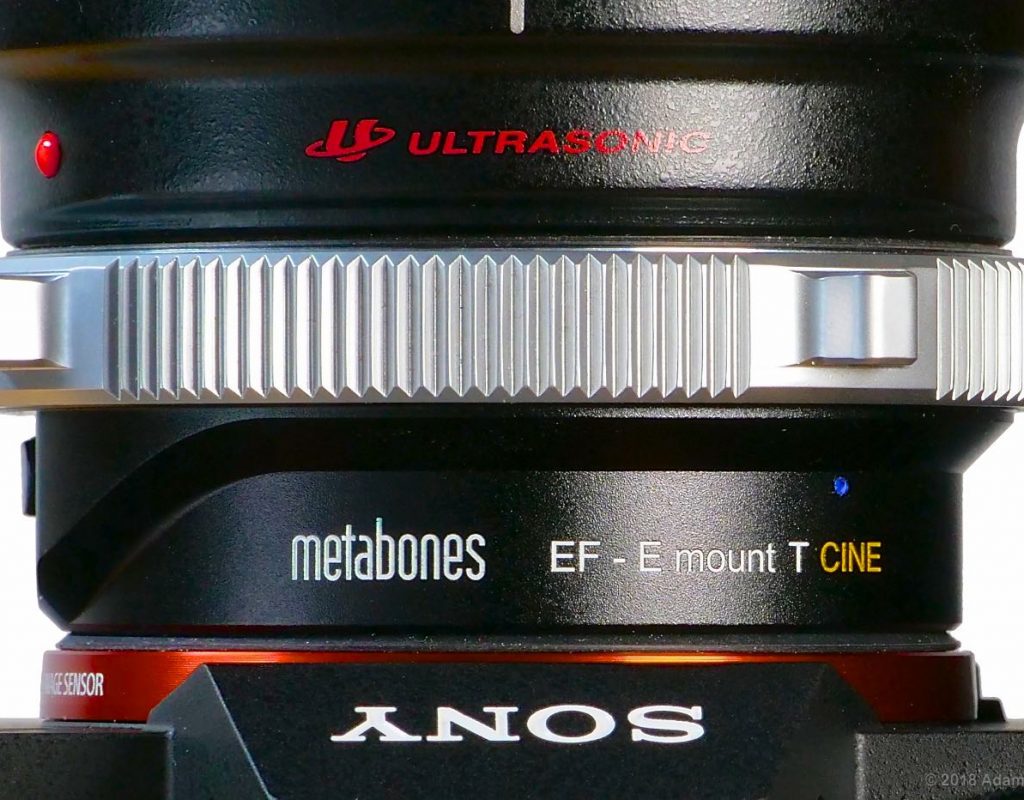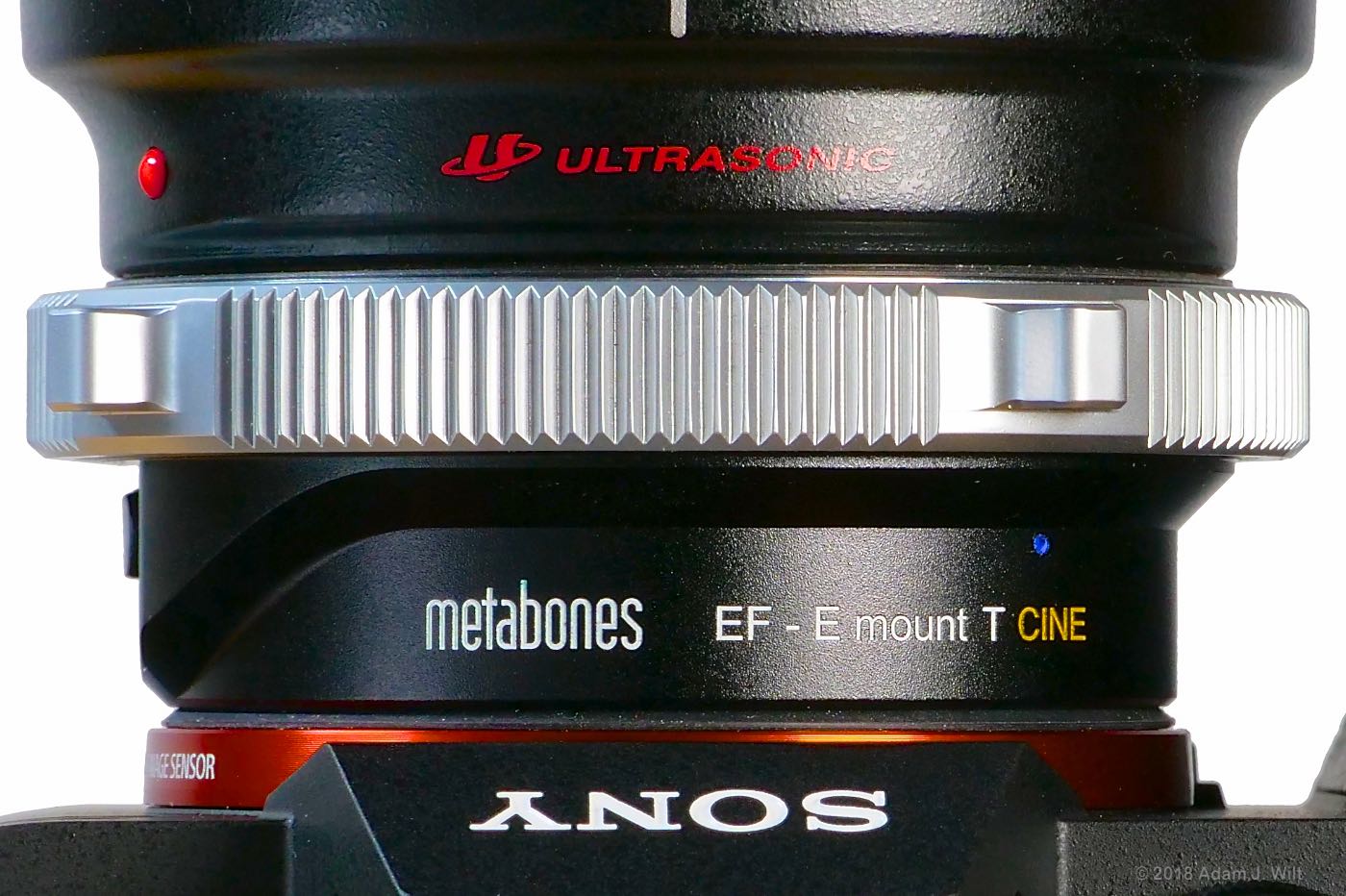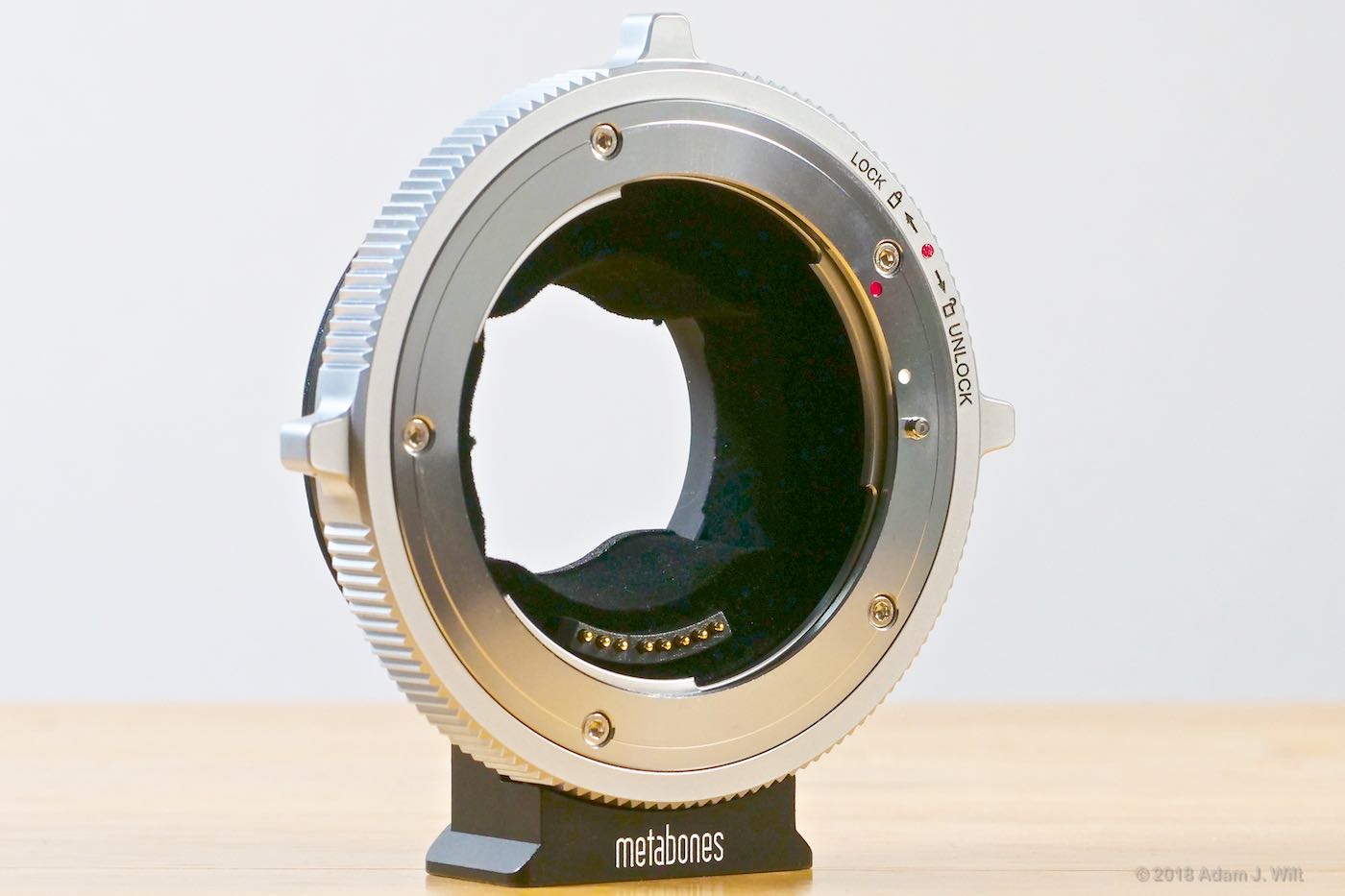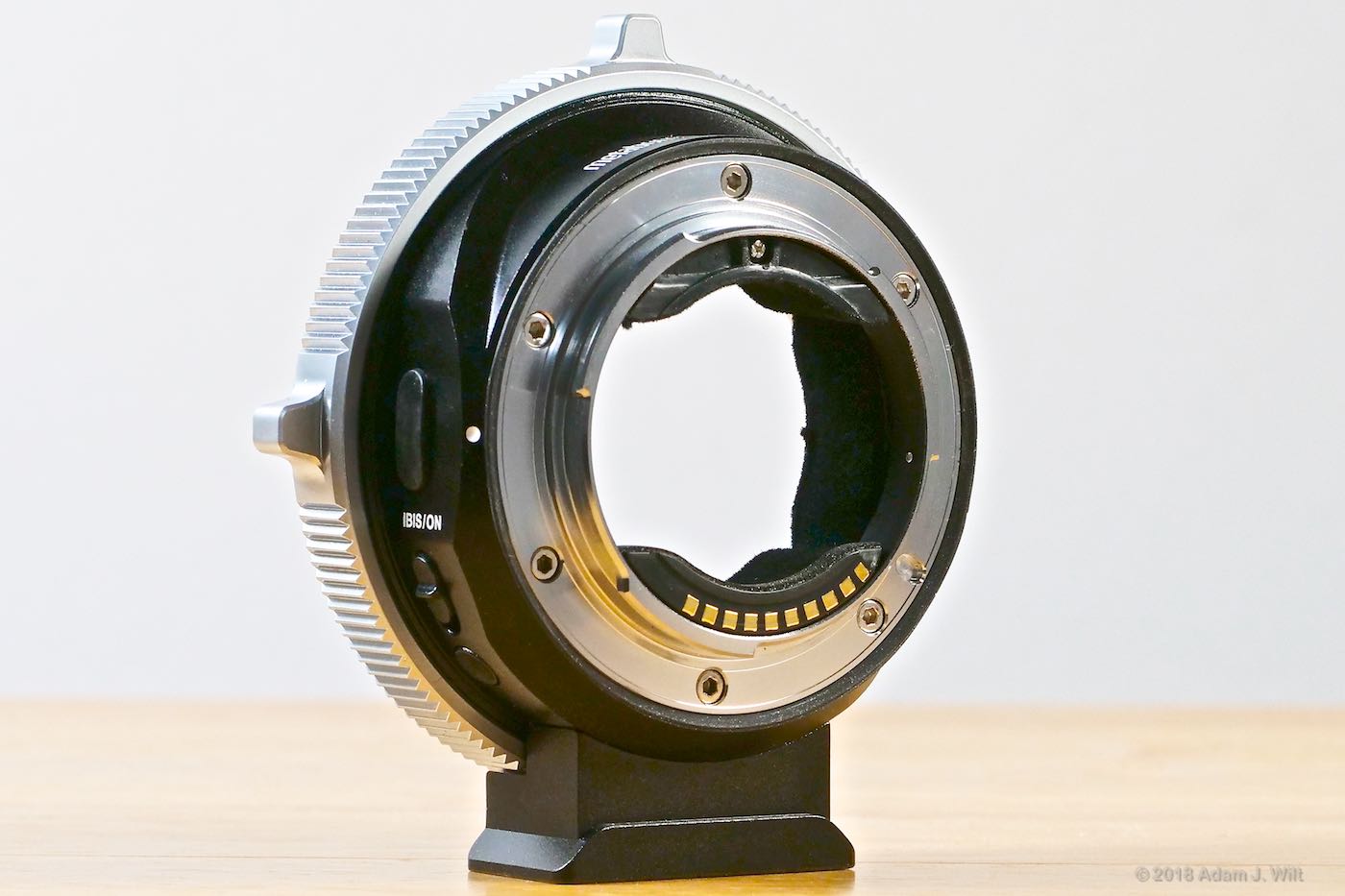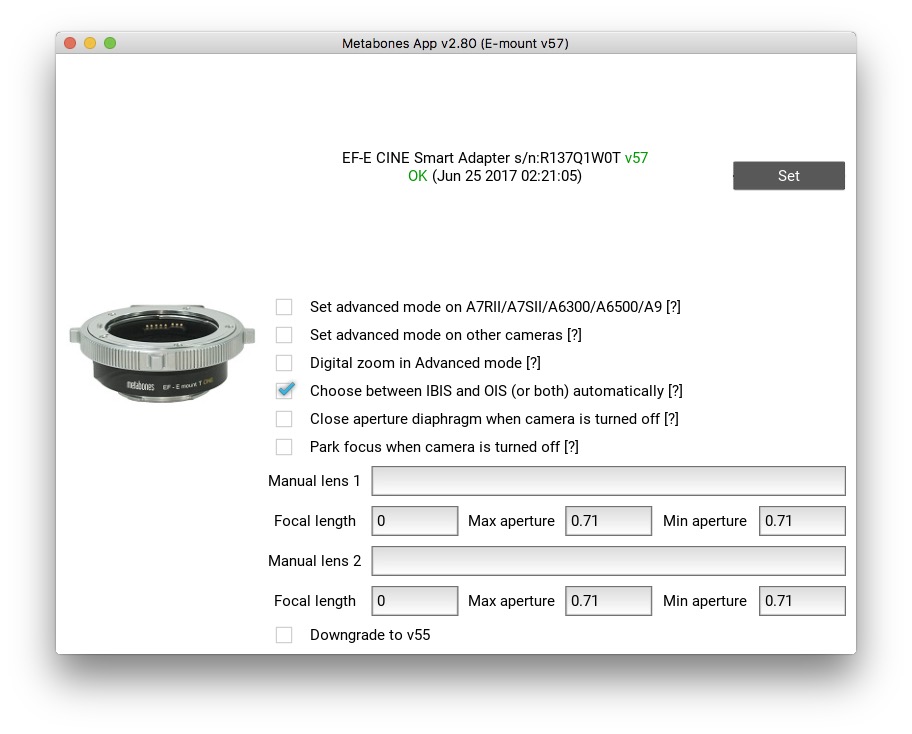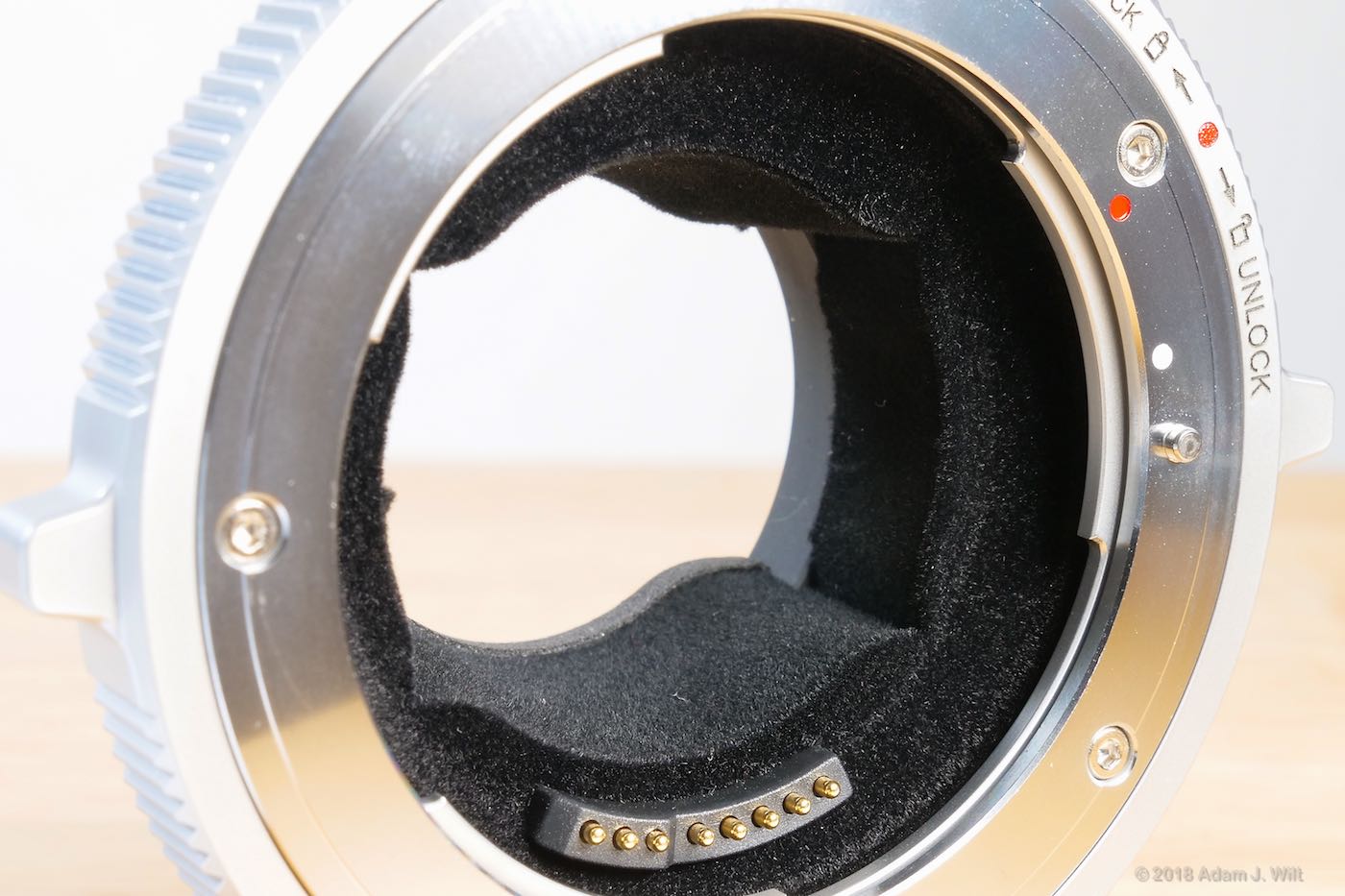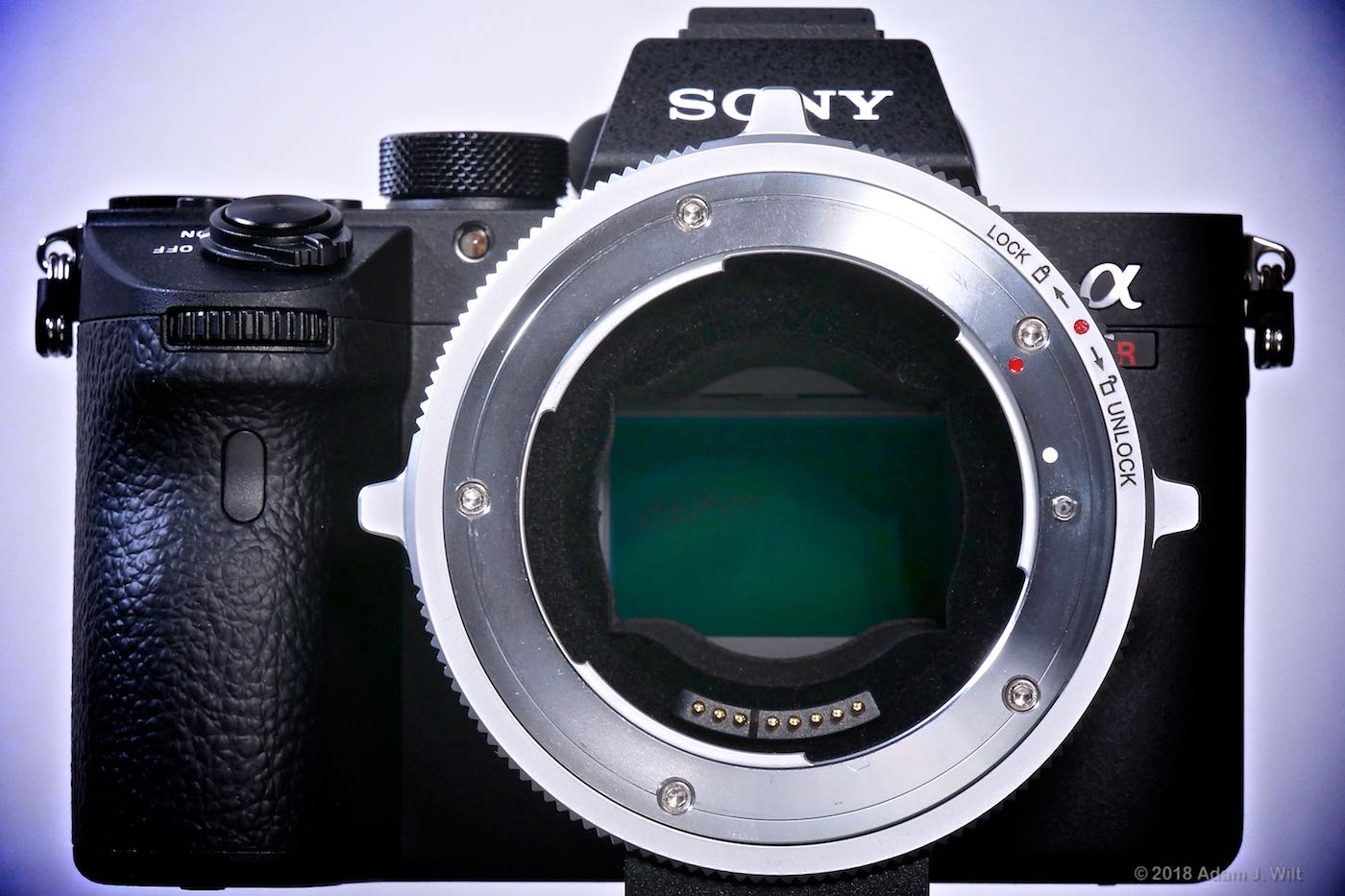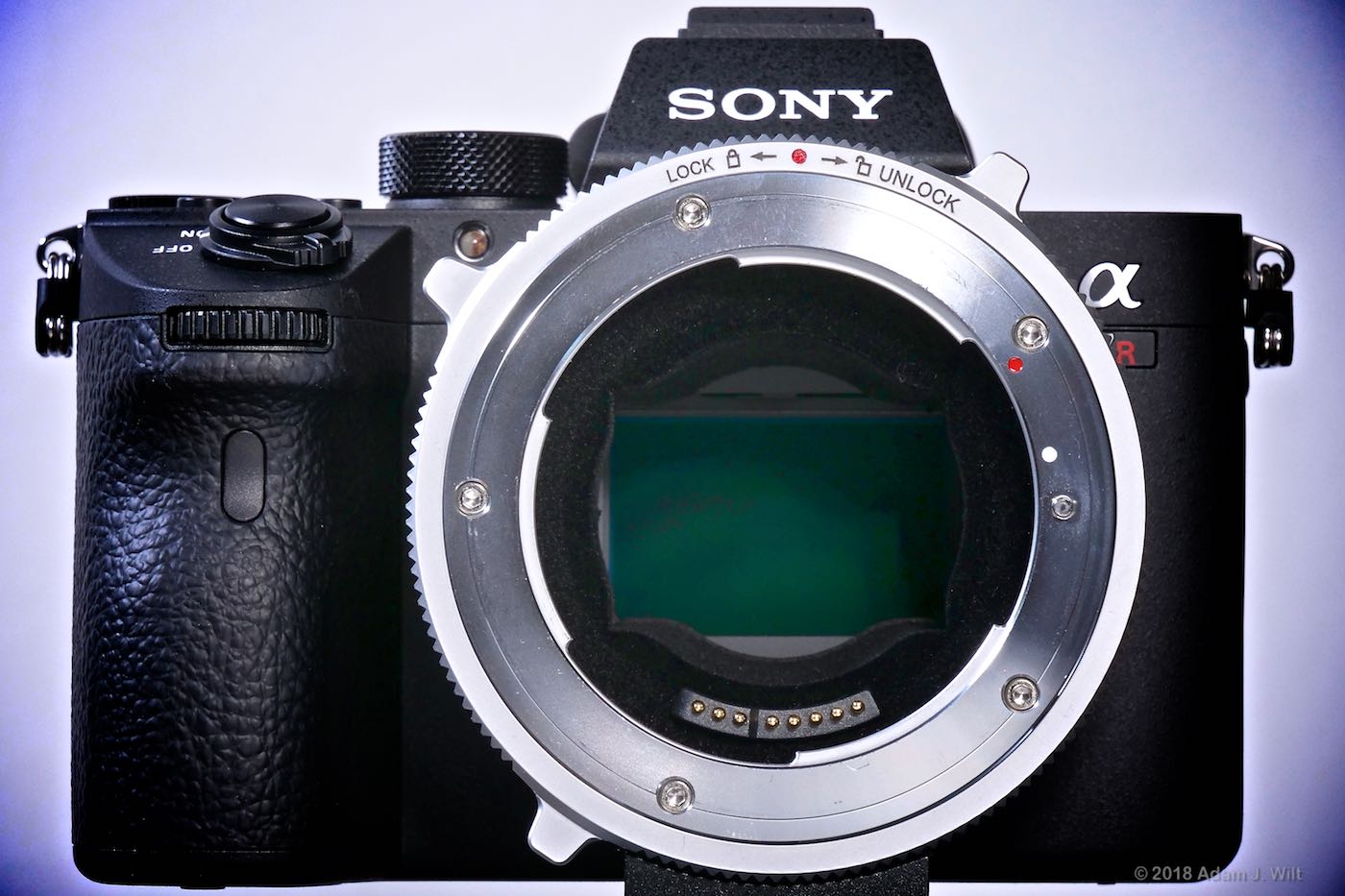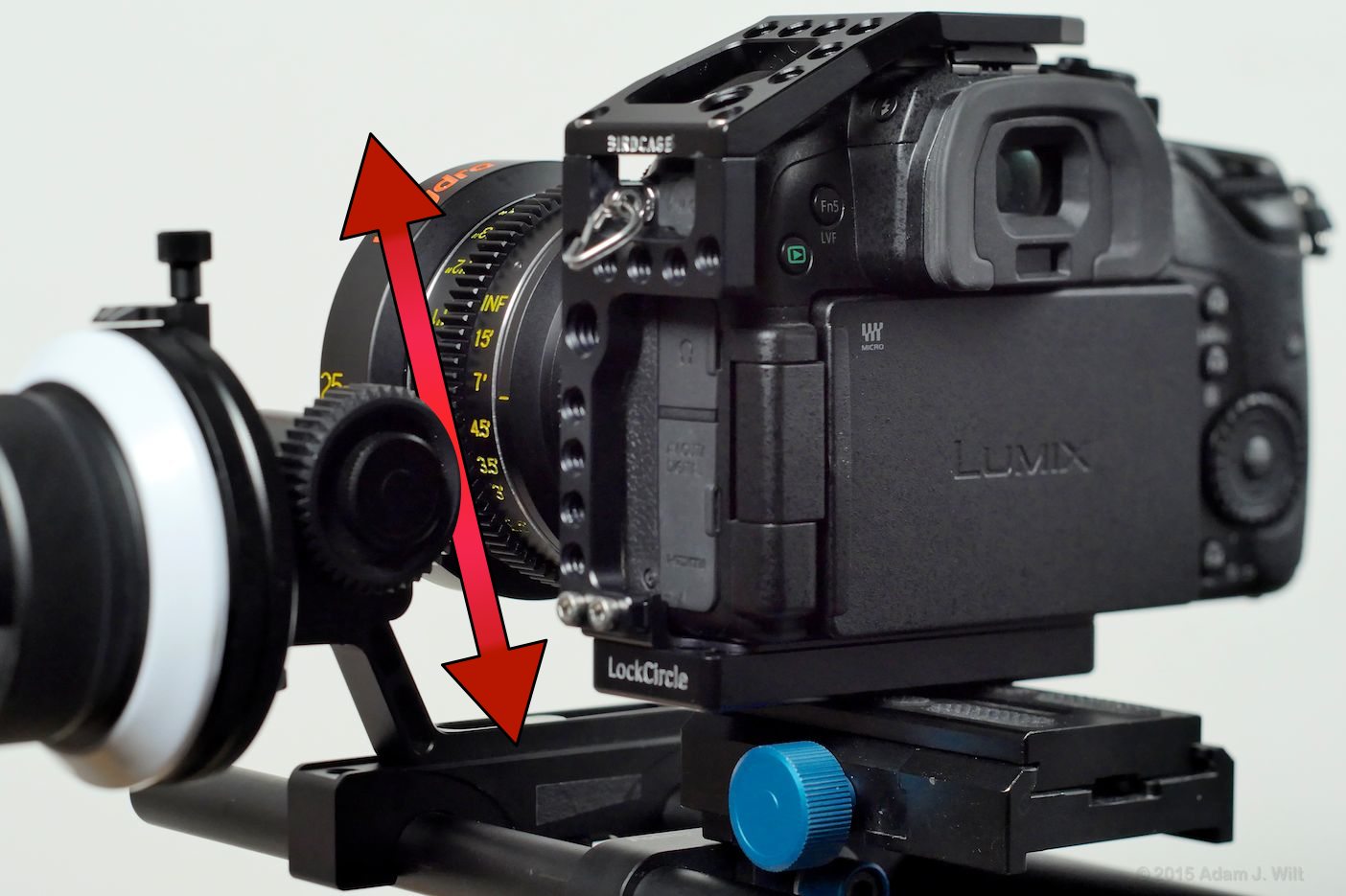One of the pleasures of mirrorless, short-flange-depth cameras is the freedom to use a wide variety of lenses via adapters. Metabones is the granddaddy of adapter companies, renowned for their Speed Boosters. Speed Boosters incorporate optical “concentrators” to squeeze a large image circle into a smaller area, preserving full-frame angles of view on smaller sensors and boosting speed in the process.
But this isn’t an article about Speed Boosters.
Not everyone needs a speed booster, so Metabones also makes adapters that simply bridge mechanical and electronic gaps between dissimilar cameras and lenses: for example, between Sony E-mount cameras and Canon EF lenses. Any proper adapter for EF lenses must provide iris control, preferably driving the lens from camera’s own commands. This is a rather harder goal to accomplish than is at first apparent, so “active” adapters come with a long list of cautions and limitations regarding compatible lenses and available functions. Speed Boosters and other concentrating adapters also add complications regarding image circles and mechanical interference issues with rearward-projecting lens elements.
I could go on at great length about these cautions, limitations, and complications, but this is not that kind of an article either.
The Quick Tour
The EF to E Mount T CINE Smart Adapter is a non-Speed-Booster EF lens adapter for E-mount cameras.
Metabones adapters come in robust plastic cases, with a rear lens cap and a front mount cap. Two hex keys are thoughtfully provided: a small one for tightening any of the front or rear assembly screws; a larger one to remove or attach the Arca-compatible tripod foot.
The adapter is dominated by the large EF mount flange, surrounded by its lockring. Note the electronic pins at the base of the aperture for talking to an EF lens.
Here’s the much smaller E mount at the rear of the adapter. The very different contact array for E mount communications only hints at the challenges in translating E language to EF language and back again.
The adapter has a pushbutton to change operating modes and a slide switch for IBIS (in-body image stabilization) signaling. Above the IBIS switch there’s a micro-B USB port for firmware upgrades, custom configuration, and even remote monitoring.
The Metabones app for Mac or Windows lets you configure the adapter’s behavior and update its firmware.
The interior of the “mirror box’ is flocked to reduce flare.
CINE mount in the unlocked position.
CINE mount in the locked position. The lockring rotates the “ears” behind the mounting flange to secure an attached lens.
Bayonets vs Breech-locks
Most adapters, whether from Metabones or other manufacturers, use the same sort of lens mount as a camera would: in the case of EF mount lenses, a bayonet mount. Bayonet mounts are quick and simple: a lens is inserted into the mount and twisted to a locking position. Leaf springs behind the camera-side mount’s ears push against the tabs or ears on the lens-side mount, snugging the lens firmly to the camera. It’s a tried and true technology, and for still cameras—and lenses operated by hand—it’s a great system.
Problems arise, however, when bayonet mounts are used to attach lenses to tripod-mounted cine cameras and when external gear drives are used—manual follow-focus controls and focus motors alike. Using a follow-focus or geared motor to perform a fast focus-pull imparts a strong force to the focus gearing. If there’s any stiffness or viscous drag in the focus ring, that force can easily rock a lens in a bayonet mount, squashing those leaf springs and flexing the lens upwards (or downwards) slightly.
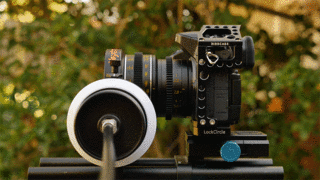 The rocking shows up as a wobble in the picture and as a slight near shift in focus: if you’re shooting wide open, you may find that the focus point you hit during the pull changes when you stop turning the focus knob and the lens settles back against its mount.
The rocking shows up as a wobble in the picture and as a slight near shift in focus: if you’re shooting wide open, you may find that the focus point you hit during the pull changes when you stop turning the focus knob and the lens settles back against its mount.
Cine cameras typically use positive-locking breech mounts to prevent this problem. A rotating collar or lockring uses wedge-shaped ears or a cam mechanism that presses more firmly against the lens’s ears the more the collar is turned.
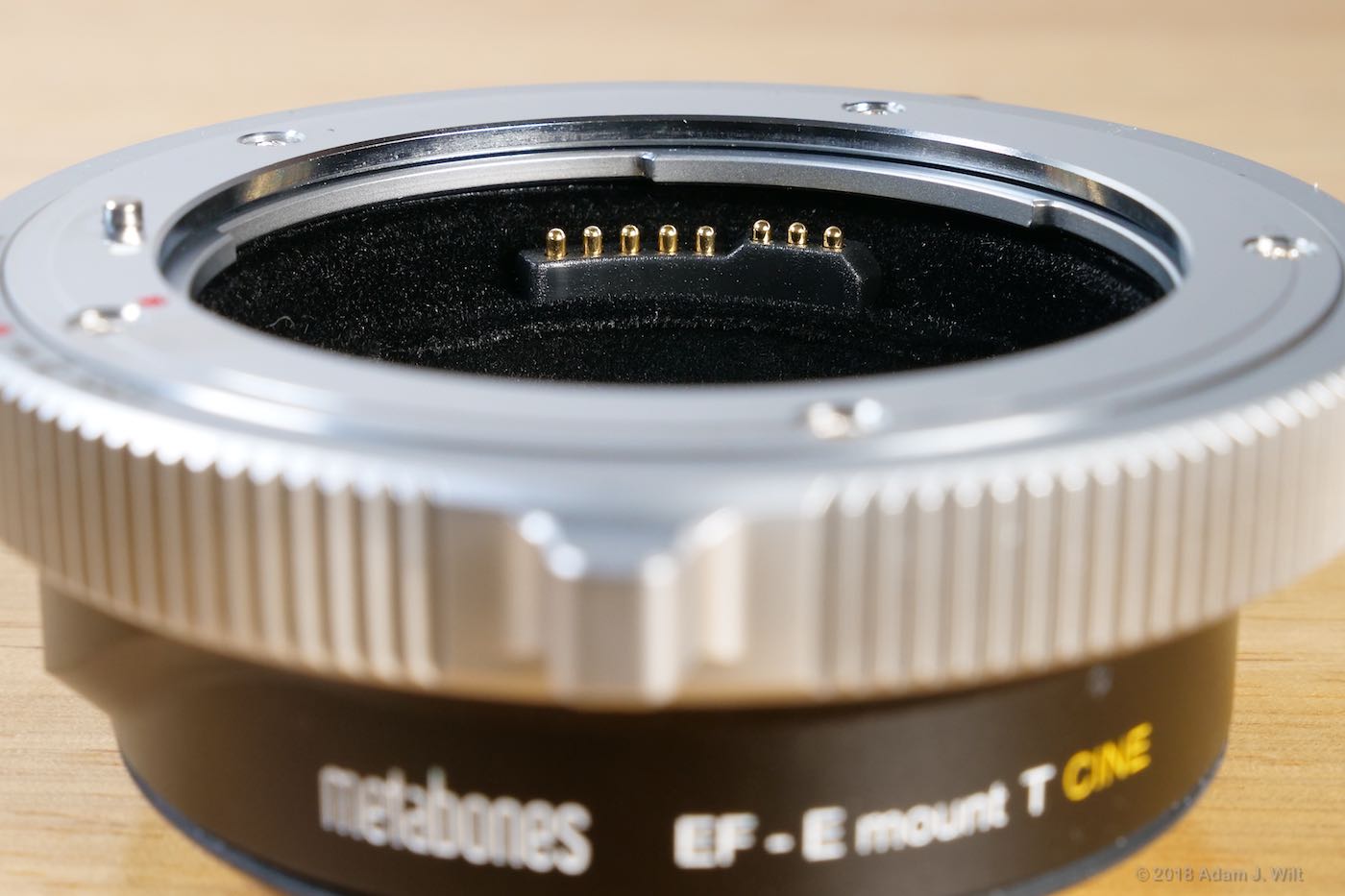
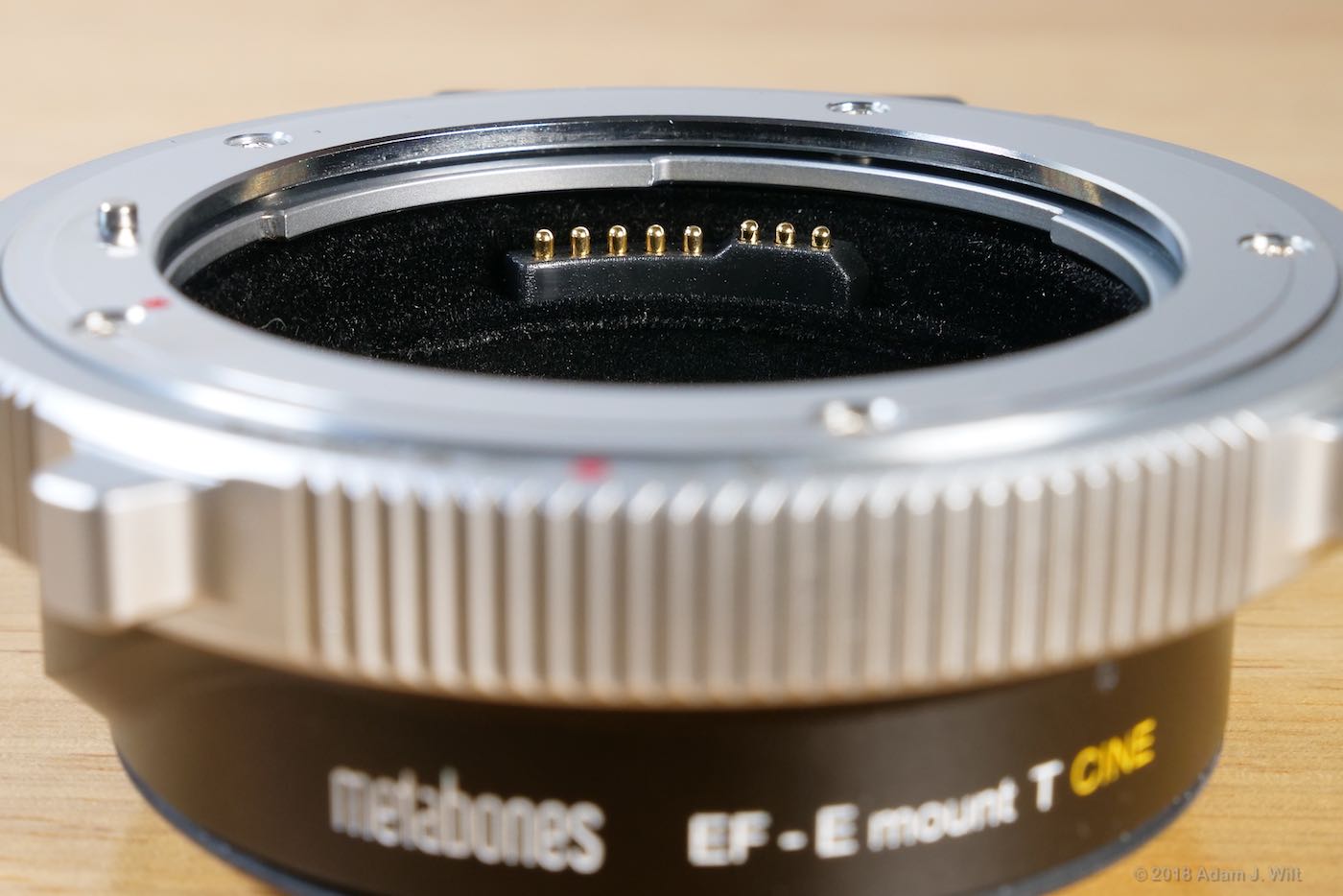
The wedge’s or cam’s “ramp” is fairly shallow so you get great mechanical advantage: by the time you feel a strong resistance to further rotation, the lens is well and truly snugged down against its flange. Lens and camera form a rigid unit; any remaining flex or bobble from enthusiastic focusing is due to elastic flexing in the lens or camera itself.
ARRI’s PL (Positive Locking), LPL, and XPL mounts are breech-locks; so is Panavision’s PV mount. Sony’s FZ mount, used on the F3, F5, and F55, is another example. Serious EF-mount cameras like the Canon C500 and Panasonic VariCam LT also use a breech-lock mechanism to mount EF lenses, and Sony’s FS7 II uses a positive-locking E mount.
With the CINE line of adapters, Metabones brings positive locking to EF lenses on E-, MFT-, and FZ-mount cameras. The breech-lock mount adds $50 to the cost of CINE adapters compared to their bayonet-mount counterparts.
Tradeoffs
Is it worth $50 to dump wobbly bayonets for robust beech locks? If you’ve been reading this far (and to be fair, how are you here if you haven’t read this far?), you’d expect me to say yes, unconditionally. Yet I’d suggest a more nuanced view.
I’ve used Metabone EF-to-E adapters before; they’re commonly part of the rental kits for PMW-FS7s, FS5s, and A7Ses/A7Siis. I recently obtained a couple of Sony E-mount cameras and I have a flock of Canon lenses, so an adapter was called for. Having previously experienced frustration with squishy bayonet mounts when putting Veydra primes on a GH4, when I saw the EF to E Mount T CINE Smart Adapter I put my (remaining) hard-earned money down without hesitation. I’ve been using the CINE adapter now for a couple of months.
The CINE breech-lock works perfectly. There is no wobble or flex between lens and adapter; they might as well be a single unit. All my Canon lenses mount quickly and precisely (a Sigma 50mm f/1.4 DG is a bit more finicky: its tolerances are very tight and it can take a bit of wiggling before the lens will seat firmly in the mount). The large silver ring with its three gripping stubs adds a PL-mount-like appearance to my lowly ILCE cameras, so I can at least play make-believe that I have a professional cinema camera at my command.
There are a few downsides to the CINE adapter, however.
1) No matter how rigidly the CINE adapter grips a lens, you’re still at the mercy of the E- or MFT-mount on the camera itself. Unless you’re using an FS7 II with its positive-locking E-mount, you’re likely to suffer spring flex and mount wobble between the camera and the adapter.
2) The knurled CINE lockring sticks out 3.5mm past the circumference of the lens mount itself, and the gripping stubs project 8mm out. With the adapter mounted on any Sony with a projecting handgrip, you’re left with very little room for your fingers: scraped knuckles are an occupational hazard when handholding.
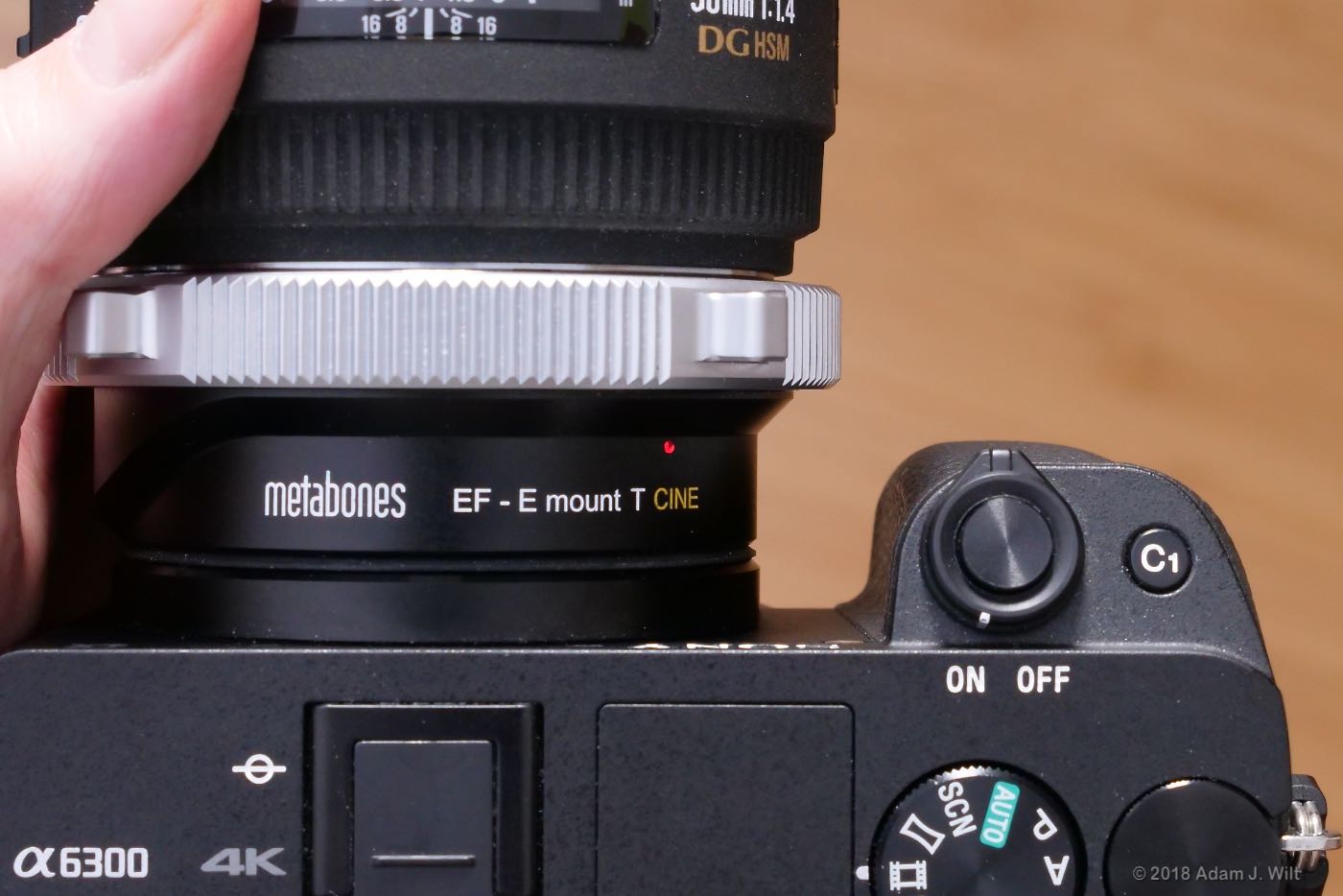
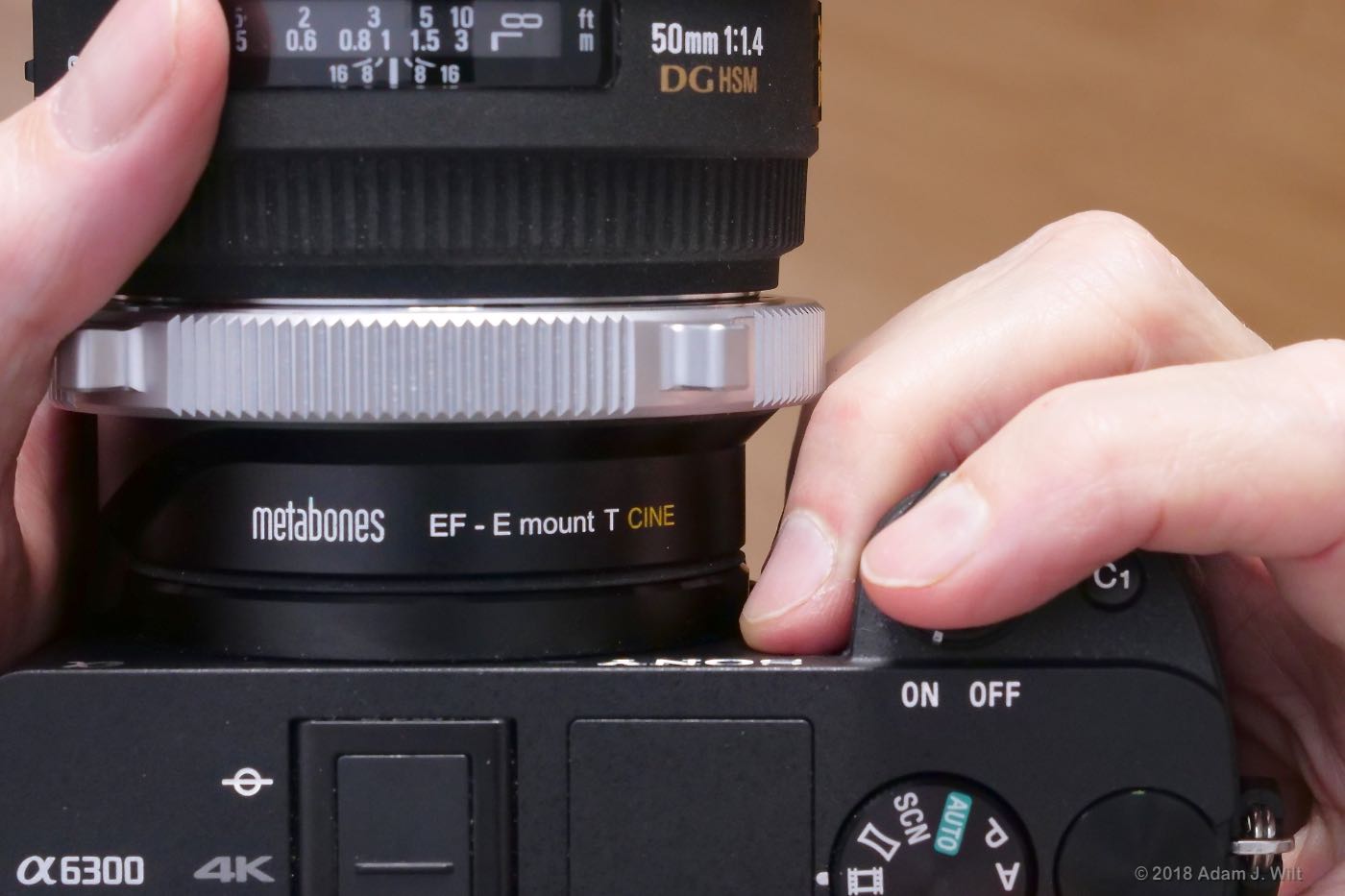
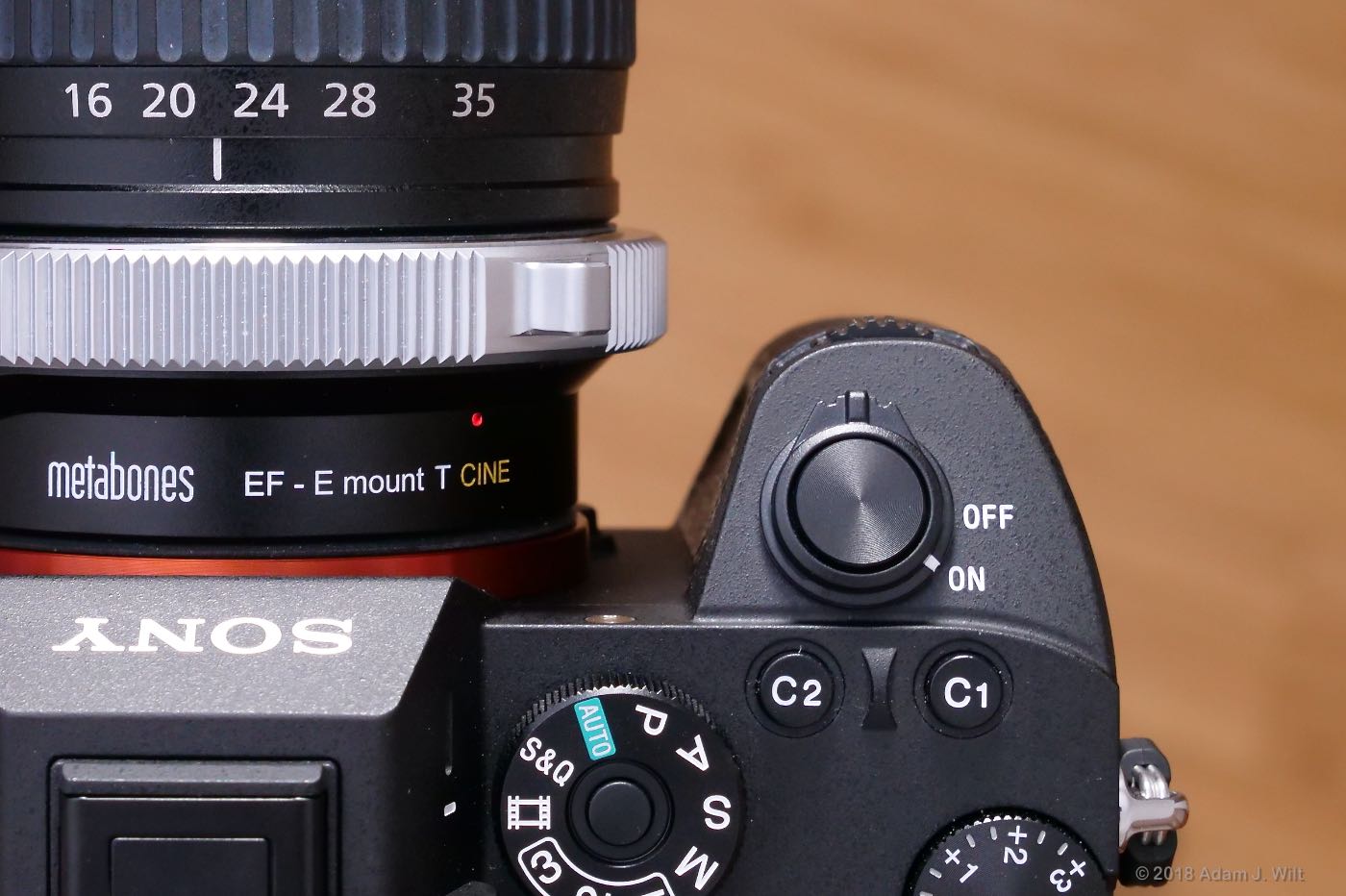
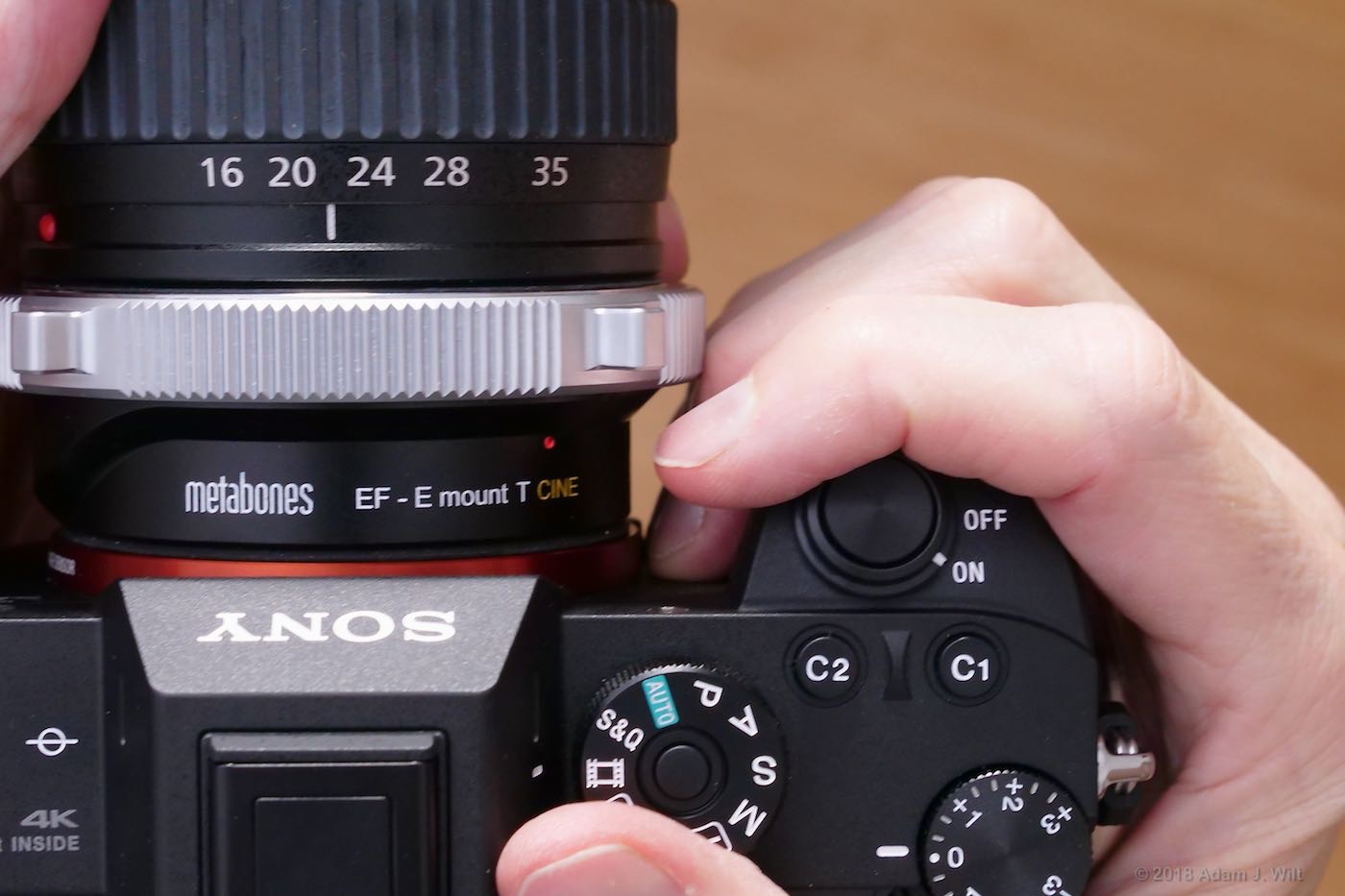
I haven’t worked with a CINE adapter on my GH4 or GH5, but I’d worry about a similar issue with those cameras’ protruding handgrips, too.
3) Because the CINE mount rotates until snug, it doesn’t have a defined stopping point, nor does it have a locking catch. You turn the lockring until it’s tight; you loosen it by twisting in the opposite direction. If you don’t tighten it sufficiently, and you’re not paying close attention, it’s possible for the ring to get turned inadvertently. If it turns too far, your lens will fall off.
True, this is no different than most other PL-style mounts, but if you’re in the still-camera, bayonet-mount mindset, you’re in a world where lenses can’t be removed without first pressing a release button. PL mounts—and the CINE adapter—don’t have that safety catch, so you can’t depend on it to save you from doing something unfortunate. You just have to be a bit more mindful as a result.
To CINE, or not to CINE?
If you’re using an FS7 II, the first two issues don’t apply, and I’d consider the CINE versions of Metabones adapters to be essential accessories. The rigidity imparted to the rig by the two locking mounts—the locking E-mount on the camera itself and the CINE mount for the EF lens—makes CINE adapters no-brainers for FS7 II kits.
With any other FS or NEX series camcorders (or an AF-100/101 or GY-LS300) you’re limited by the floppy bayonet mount on the camera, so the solidity of the CINE’s grip on the lens is of less help. You’ll still need to rig rigid lens supports if you want to use a follow-focus or lens motor without wobble or flex. The no-twist mounting of lenses on the CINE adapter remains worthwhile, as you can swap lenses with a follow-focus in place and not worry about spinning the follow-focus against its hard stops in the process.
(If you’re shooting with an NEX-VG camcorder that has part of its handgrip projecting forward of the mount, you also need to check clearances; the larger diameter of EF lens flanges, as well as the fatter CINE lockring, may prevent you from fitting the adapter in the first place. I haven’t tried to fit a Metabones adapter on any of these camcorders myself; I’m just cautioning you that there may be a problem.)
For Sony ILCE and Panasonic G/GH-series users it’s a much harder call. In addition to the floppy bayonet mount issue, there’s the crowding of the fingers between the camera’s handgrip and the adapter’s lockring. Yes, lenses are solidly attached to the adapter; you won’t spin a follow-focus during lens changes; and there’s an undeniable cool factor in having a real lens mount on your puny camera. Whether these are sufficient benefits to offset the drawbacks is something you’ll have to determine yourself.
I should also point out the removable tripod foot on the adapter. If you use that as the mounting point for the camera (Metabones makes a handy rod adapter for that purpose), along with a lens support, you’ll have a rigid structure where it counts. A lightweight ILCE or GH-series camera simply dangles off the back of the adapter, and its mount isn’t subject to any more stress than the weight of the camera’s body. (Mind you, if you start bolting heavy monitors, recorders, and wireless receivers to the camera itself, all bets are off: better to affix those accessories to the rods alone, or mount the camera and the adapter to the rods.)


In my case, I’m willing to suffer the occasional barked knuckle for the rigidity of the breech-lock. Even though most of the time I’m using my ILCEs as still cameras, I occasionally strap ‘em down on rods for video. I appreciate the added solidity and the ease of changing lenses without having to move the follow-focus away first.
Fine, but how well does it work?
“The marvel is not that the bear dances well, but that the bear dances at all.”
— Russian saying
I’ve used the EF-to-E CINE adapter on Sony A6300, A7ii, and A7Riii cameras. I have one “video aware” Canon lens, the 70-200mm 1:2.8 L IS II USM; and several older lenses: the 24-70mm 1:2.8 L USM, 16-35mm 1:2.8 L II USM, and TS-E 90mm 1:2.8. I also used a Sigma 50mm f/1.4 DG. All the lens designs other than the 70-200mm predate the Canon 5D Mk II and its video capabilities, so they weren’t engineered for the smooth and silent aperture changes required in video work. They’re also optimized for snappy stills-mode autofocus, not the gentler, smoother focus pulls used for video.
The adapter operates in one of two modes, a “green” (power-saving) mode emulating a Sony LA-EA adapter and an advanced mode emulating a native E-mount lens.
Autofocus
For stills, the green mode works surprisingly well: AF focused on the subject in well under half a second in most instances, with very little hunting. Focusing EF glass on the adapter isn’t quite as quick as with a native Sony lens, but it isn’t far behind, and it works in pretty much any situation where AF works using native glass.
Advanced mode spends more time hunting and fails more frequently, usually in underexposed, low-contrast situations.
For video, green mode AF doesn’t work worth diddley-squat: you need to half-press the shutter button to trigger a focus attempt, and nine times out of ten any lens I used wound up focused farther out than the subject.
In advanced mode, I get reasonably consistent video AF using the 70-200mm, with focus properly achieved within a couple seconds of aiming the camera at a subject.
With other lenses, it’s much more hit-or-miss; when the lens is already close to correct focus, AF usually succeeds, but if the focus is way off to begin with, AF often drifts hesitantly towards infinity, where the focus either dithers back and forth or the camera gives up completely. Half-pressing the shutter button almost always forces correct focusing, but at the expense of racking focus back and forth, even when it’s already pretty close to start with. I find it more useful to grab the lens’s focusing ring and get the focus close, then let AF take over for fine-tuning, though it’s not consistent enough for me to trust it on real productions. (Yes, I ran Metabones’s recommended calibration procedure for each lens, and it helps somewhat—but not enough that I’ll trust video AF.)
Overall, I’d stick with green mode for AF when shooting stills. For video, I’d stay with manual focus.
Aperture
Iris control is very lens-dependent. The video-aware 70-200mm changes aperture smoothly and silently in both auto-iris and manual modes. The other lenses step noisily and visibly between stops, just as when I used those same lenses on the Panasonic EVA1. Quite simply, the adapter can’t make a lens perform any better that it was designed to perform.
Be aware that in green mode, auto-iris doesn’t operate once video recording starts: you’re stuck with the aperture you had when you mashed the REC button. Switch the adapter to advanced mode if you use S or P exposure modes and want iris to change automatically. If you’re in M or A exposure modes, no worries: you can manually twiddle iris regardless of the adapter’s mode.
Overall?
The darned thing works so well for stills shooting that I no longer worry about whether I’m using a native lens or an adapted EF lens (granted, I’m not shooting sports, so the difference between, say, AF in 0.1 second vs AF in 0.25 second isn’t an issue for me). The fat CINE lockring does tend to remind me that it’s there when I pick up the camera; if I were solely shooting stills I’d likely opt for its non-CINE counterpart instead.
For video, the adapter holds my lenses firmly in place and gives me full aperture control, and those are the most important things I need. Reliable AF would be nice, but I can always use a native lens when AF is required. The Metabones lets me use glass I wouldn’t otherwise be able to use, and some of that glass, like the TS-E 90mm tilt/shift lens, is manual focus anyway.
Conclusion
Metabones adapters are expensive, but they’re worth it: their build quality is high, they’re compatible with a wider range of lenses than other adapters, and their firmware is easily upgradeable. They’re widely considered to be the least unreliable adapters available (damning with faint praise? No; remember the dancing bear).
The CINE line adds $50 to the cost, giving you a rigid breech-lock lens mount in place of the wobbly bayonet mount. If you’ve ever suffered lens wobble while pulling focus the value of a breech-lock mount will be immediately apparent, but if that’s not the sort of problem you have (or are likely to encounter), the benefits are less overwhelming. As to the downside, the CINE’s lockring sticks far enough out from the mount diameter that it crowds an already tight clearance between fingers and lens on a handheld ILCE or G/GH camera.
If you’re shooting with EF glass on a Sony FS7 II, a CINE adapter is the way to go: combined with the FS7 II’s positive-locking E-mount, it will give you a solid connection between camera and lens.
If you’re using another E-mount or MFT-mount camera, you’ll have to decide whether the added rigidity is worth $50 and the occasional scraped knuckle. It works for me, but your mileage may vary.
Pros
- SOLID! Eliminates a weak link that contributes to lens wobble when using a follow-focus or lens motor.
- Lenses can be mounted / unmounted without rotating them.
- Makes your crummy little E-mount or MFT-mount camera look like a real camera with a proper lens mount! At least if you squint a bit.
Cons
- $50 more expensive than the corresponding bayonet-mount adapter.
- Lockring will bark your knuckles on handheld Sony ILCE and Panasonic G/GH series cameras due to tight clearances.
- Unless your camera has a positive-locking mount itself, the CINE adapter only eliminates one of the two weak links that contribute to lens wobble when using a follow-focus or lens motor.
Cautions
- Lockring doesn’t have a safety catch or lens locking button; make sure you keep it snugged down tightly to prevent unscheduled disassemblies.
Disclosure: I bought all the stuff I’ve written about here with my own money at market prices. There is no material relationship between me and Sony, Canon, Metabones, Sigma, or Panasonic, and no one has paid me anything for a favorable mention.

Filmtools
Filmmakers go-to destination for pre-production, production & post production equipment!
Shop Now